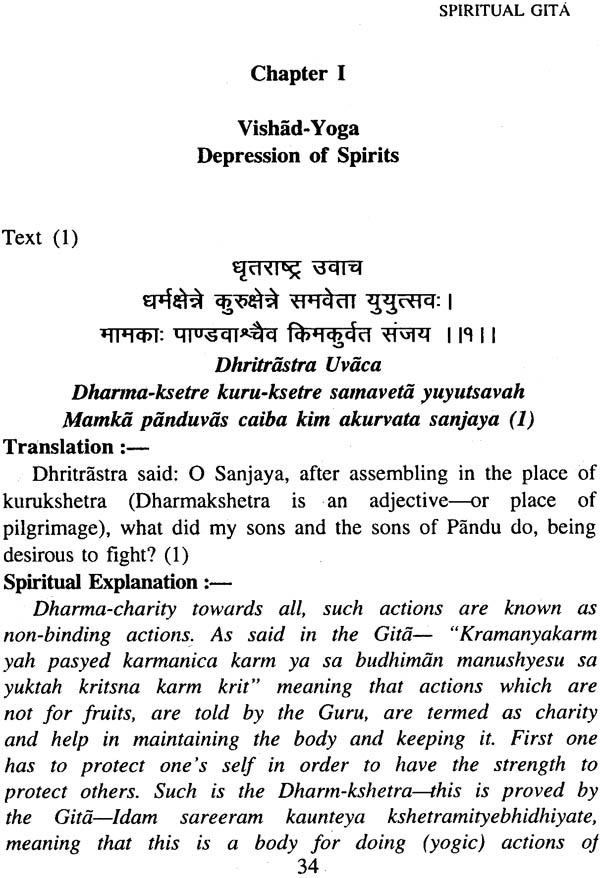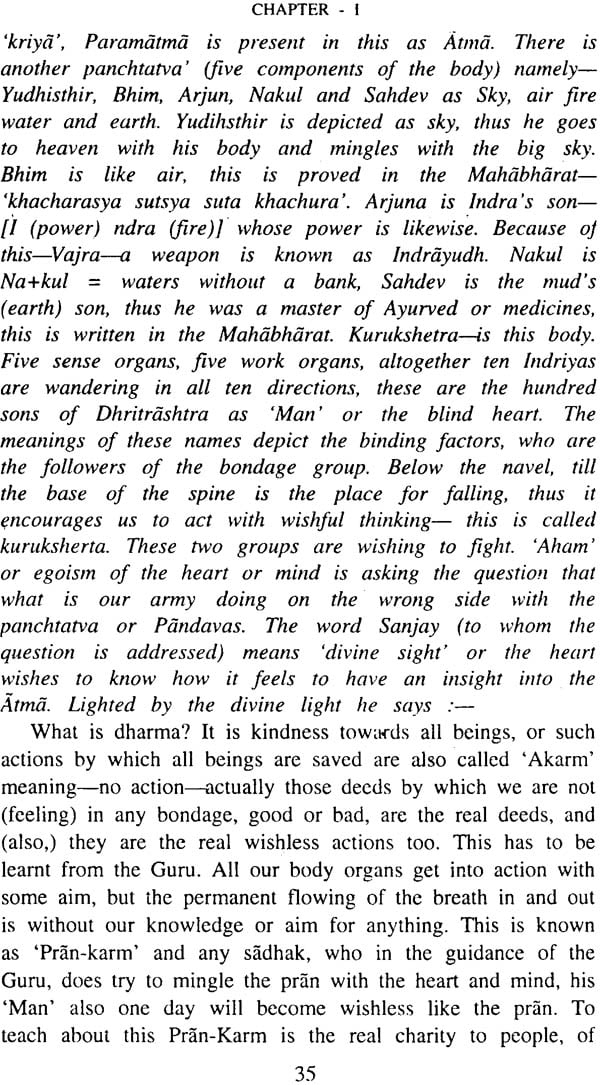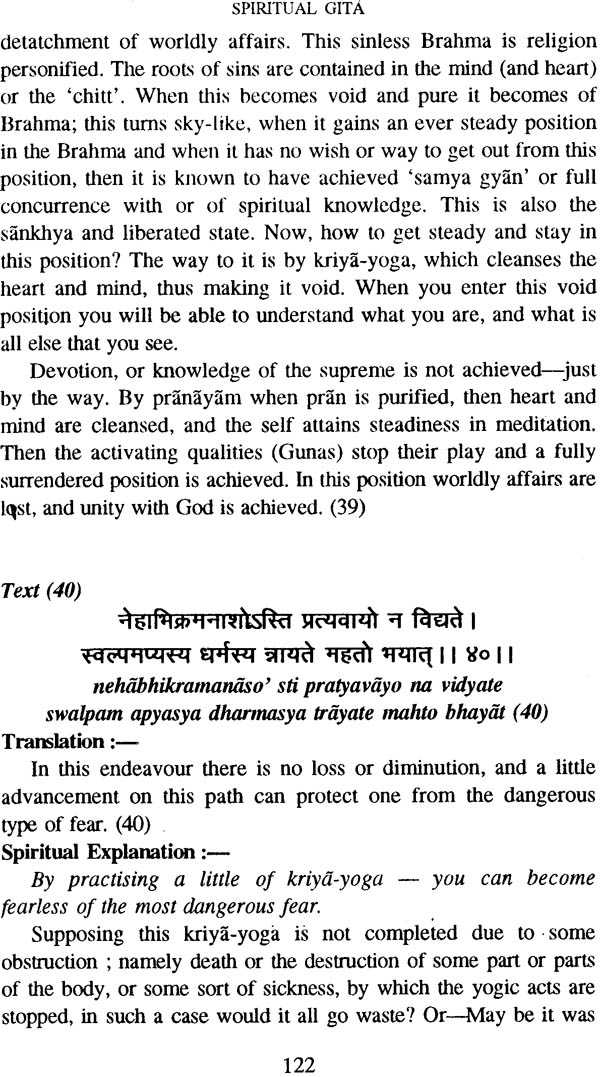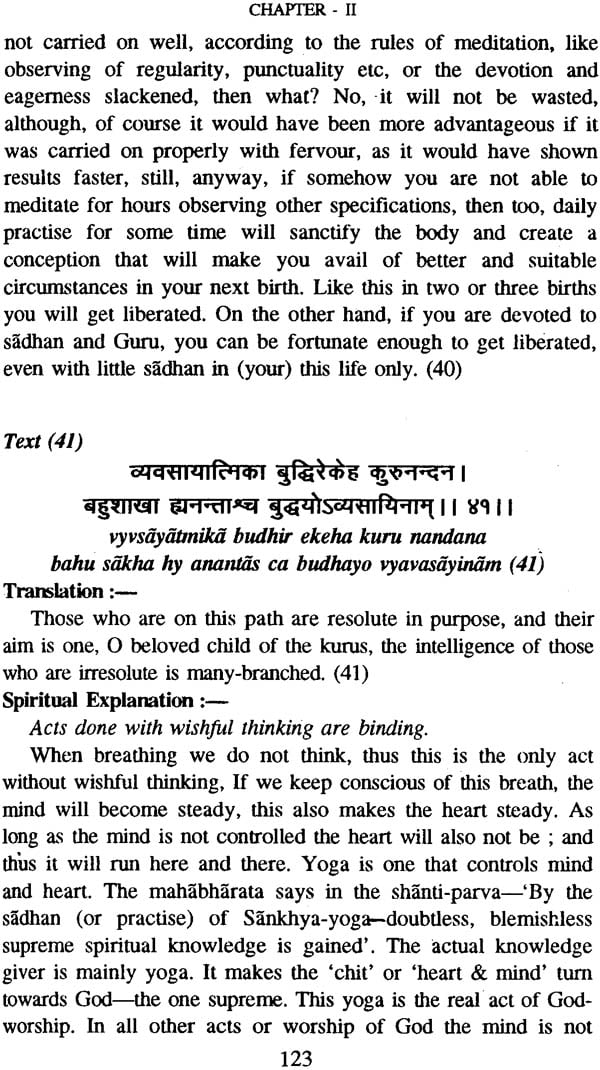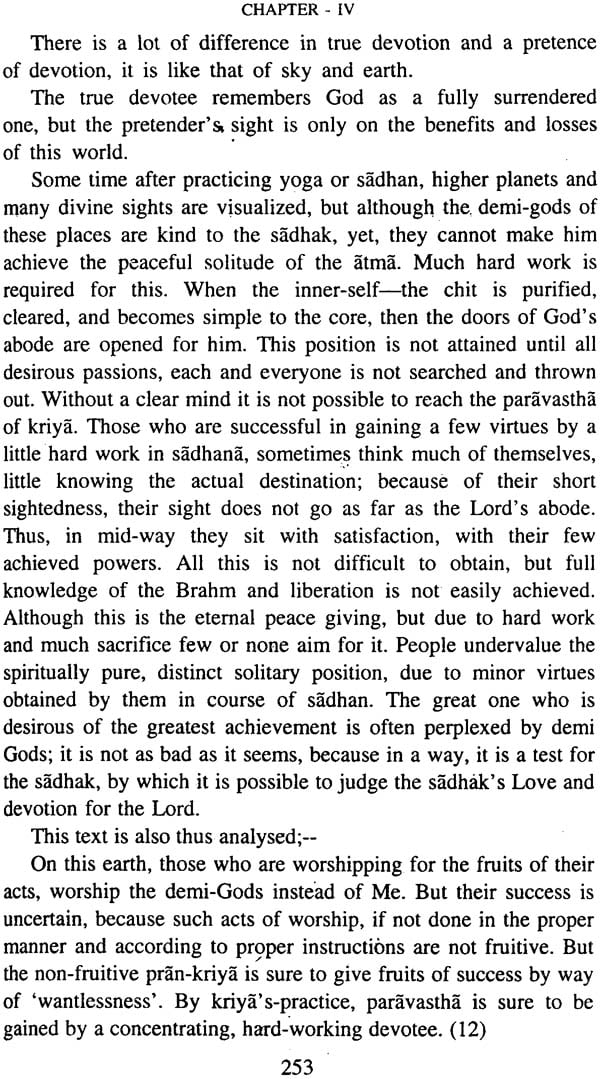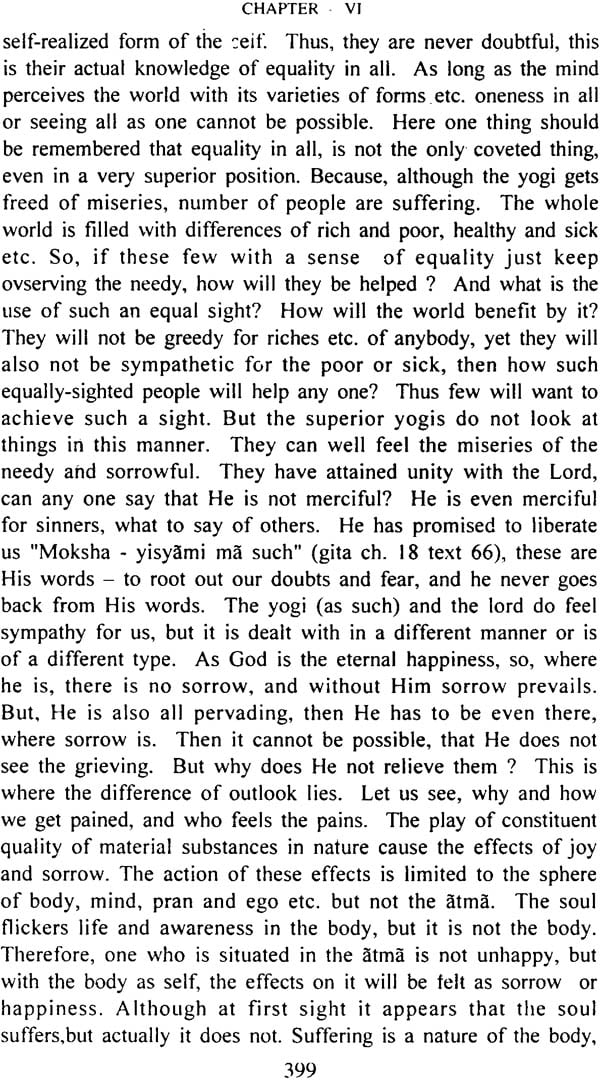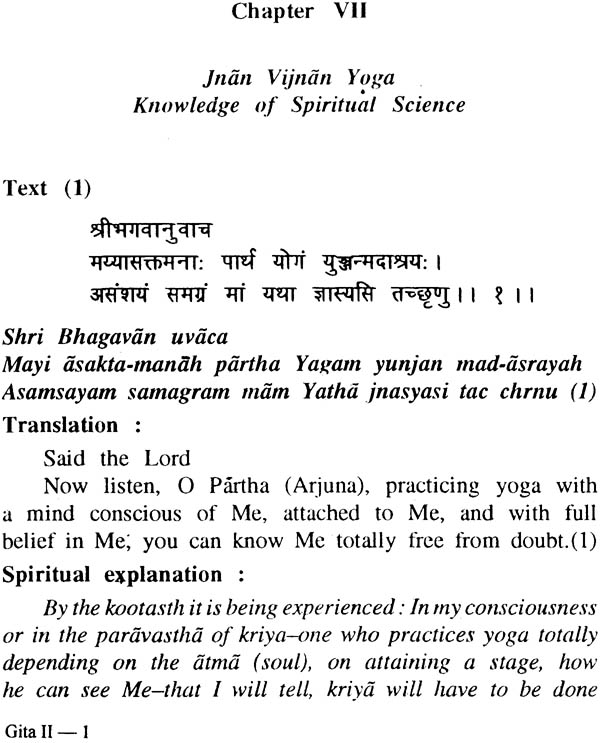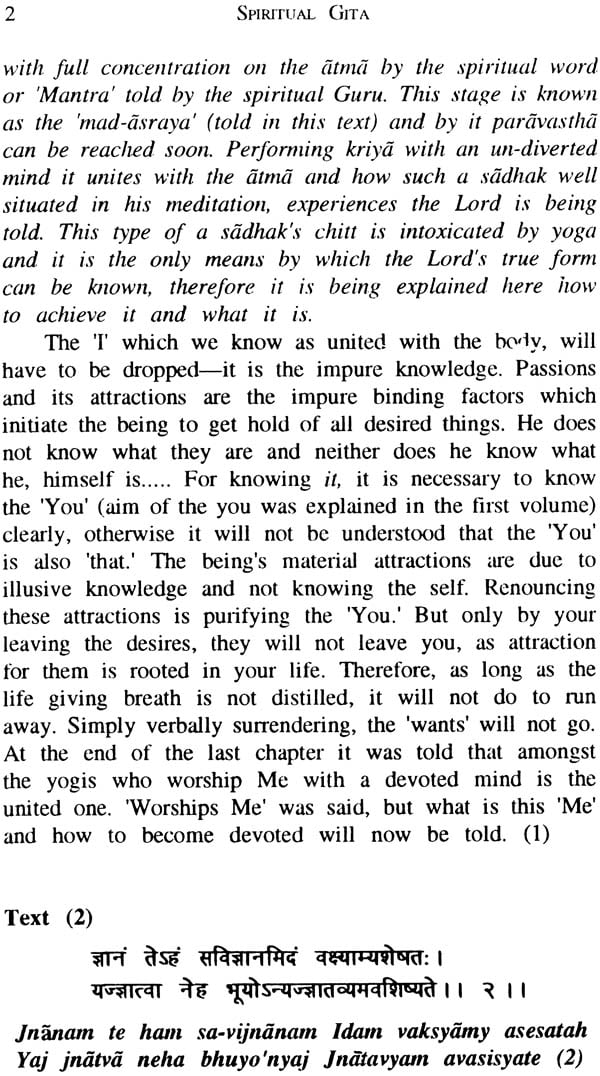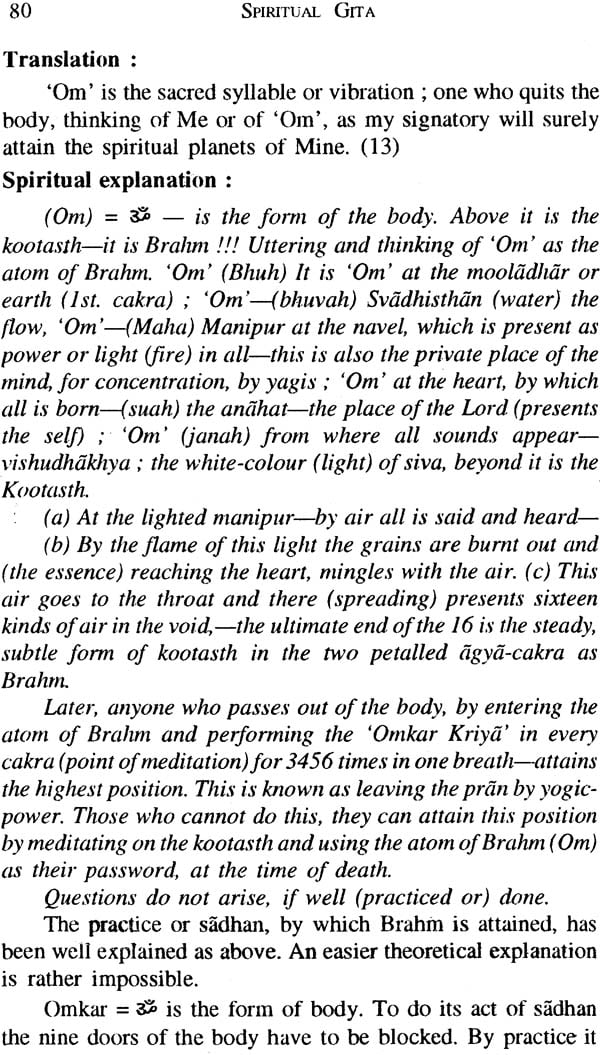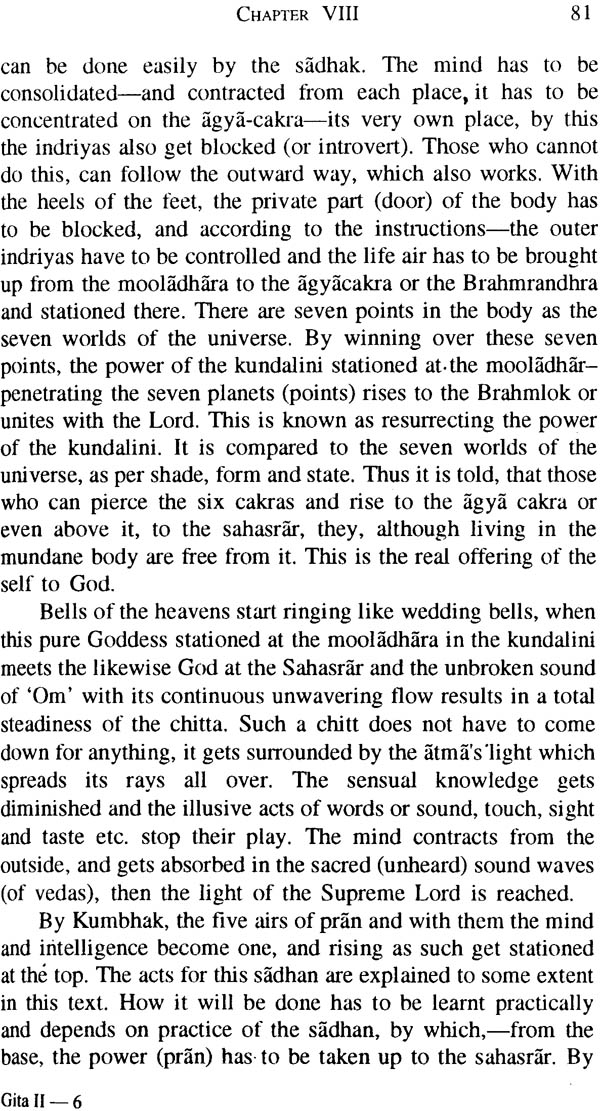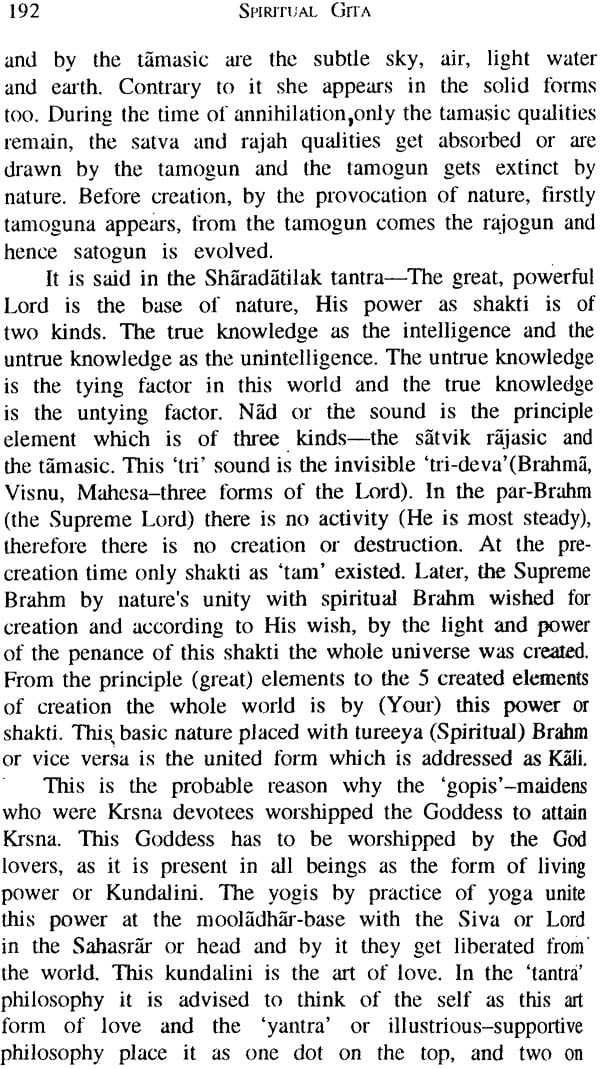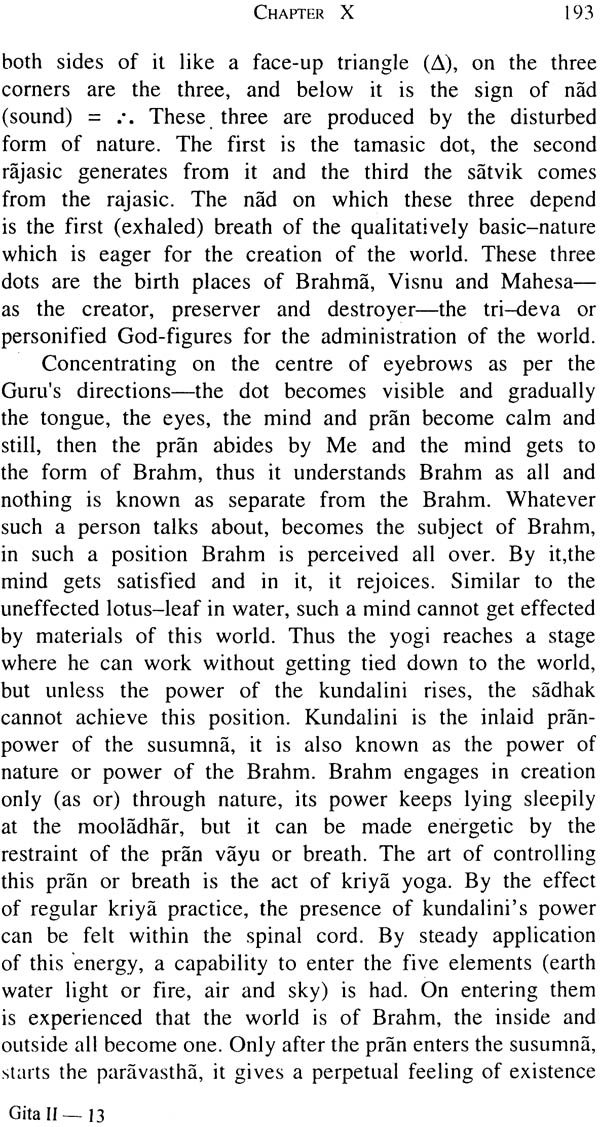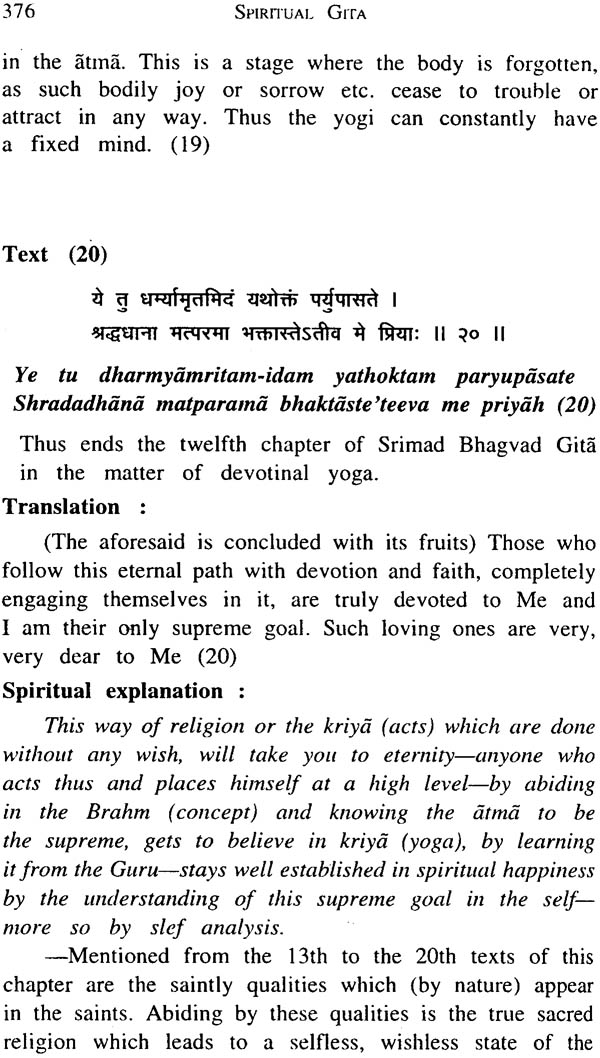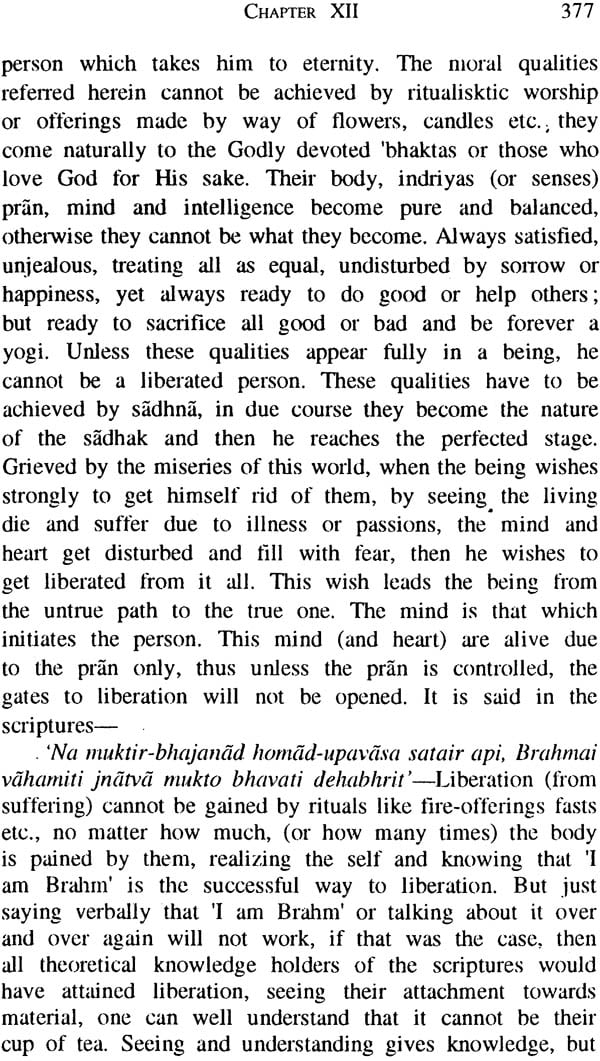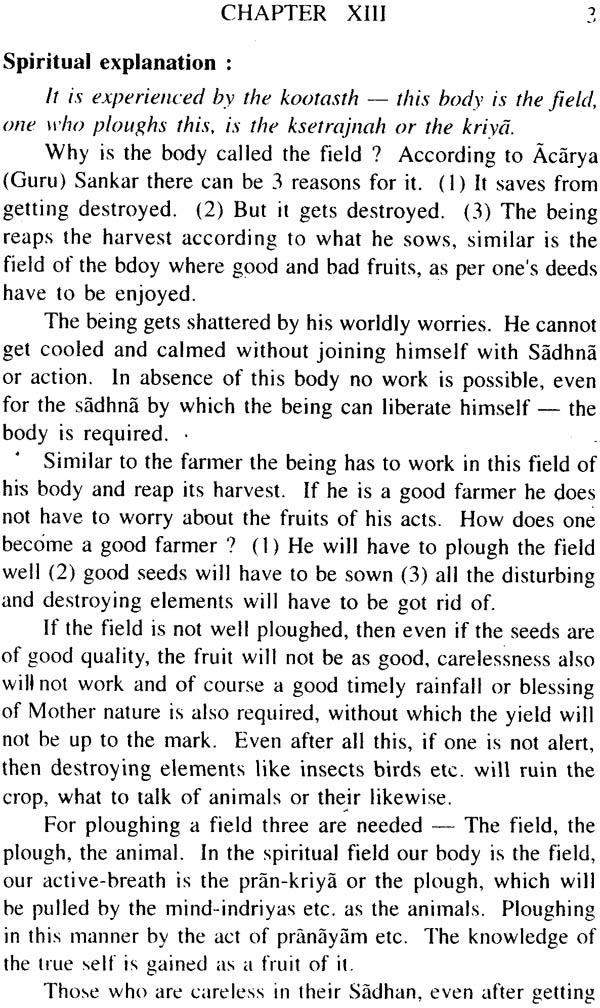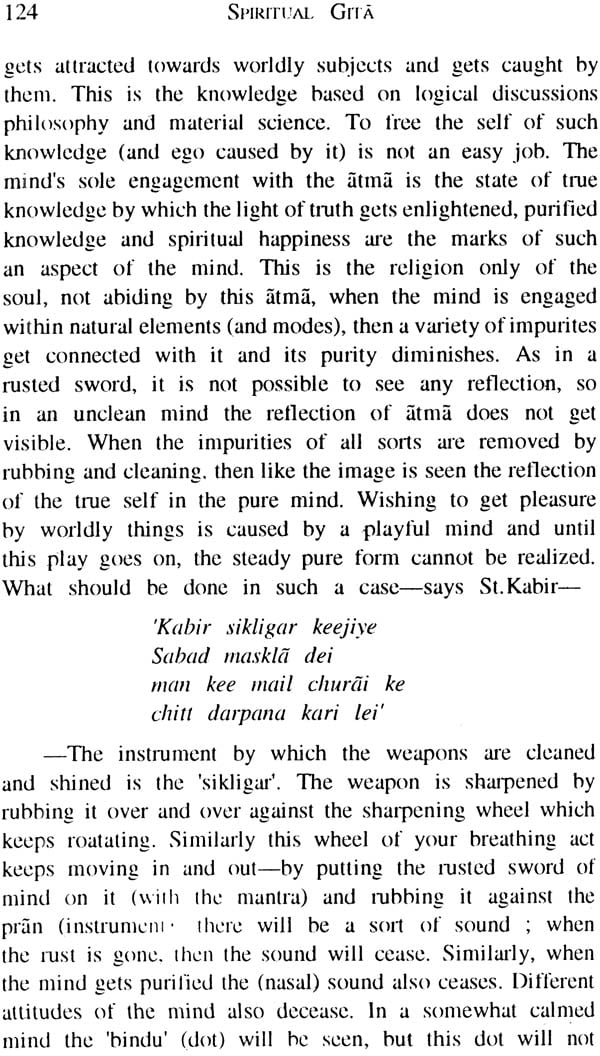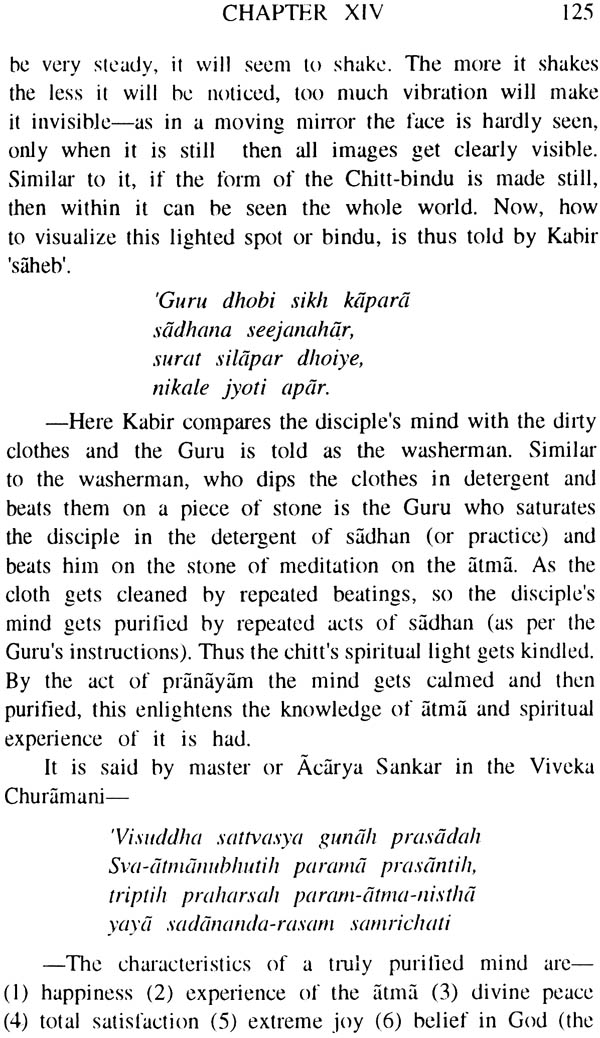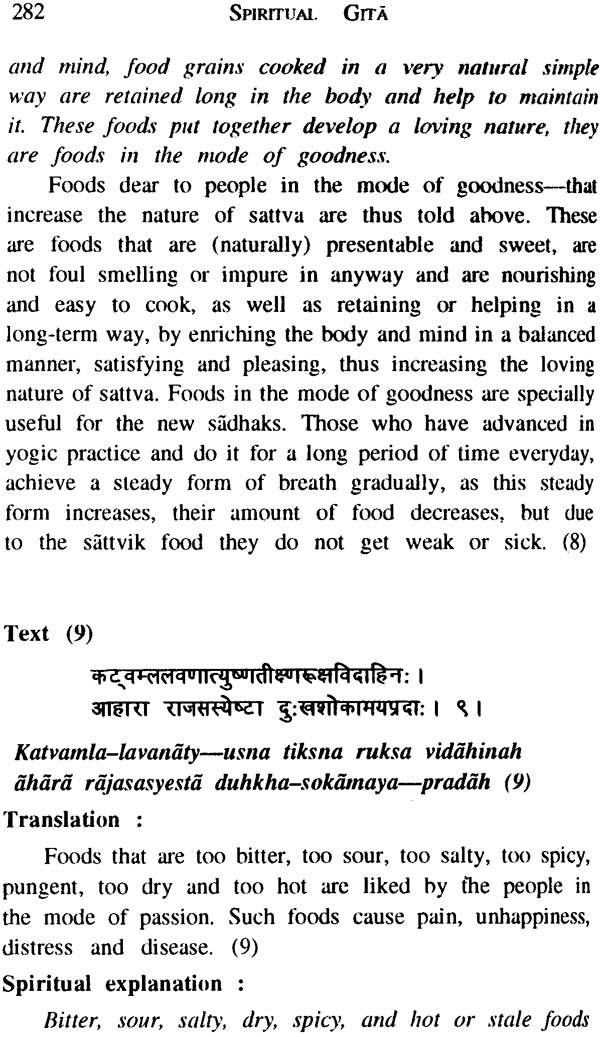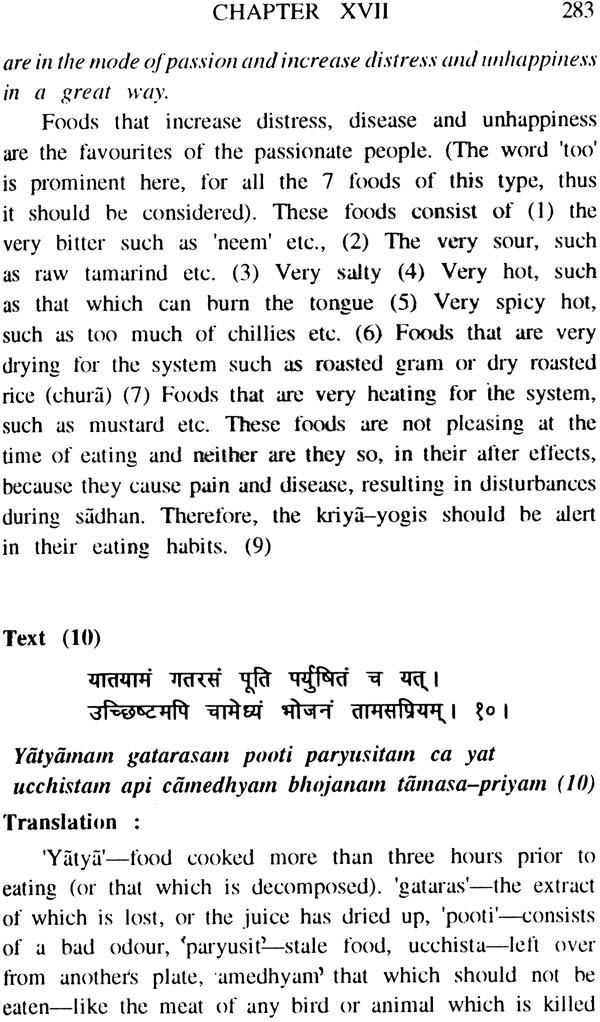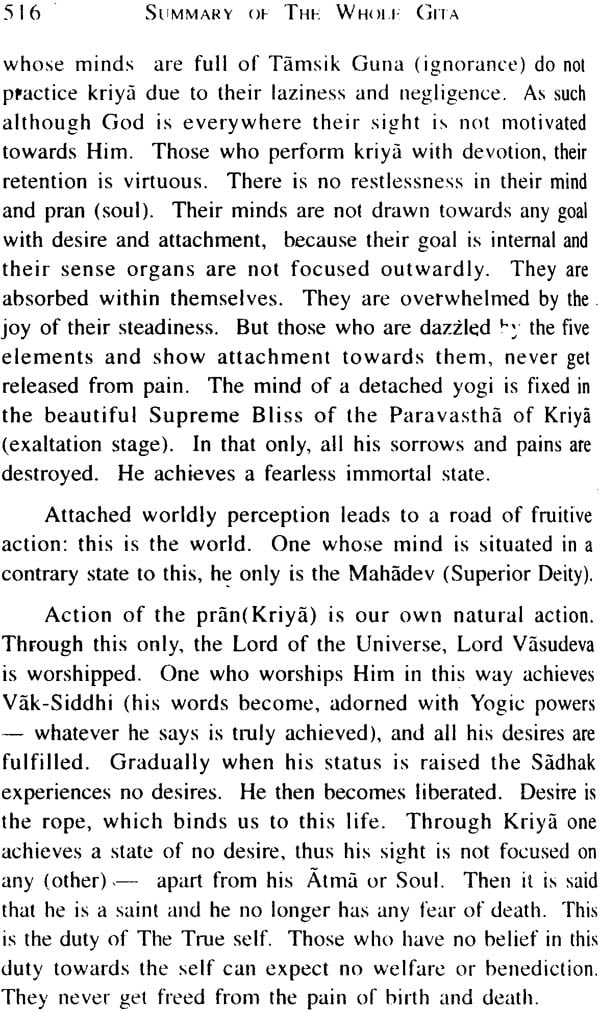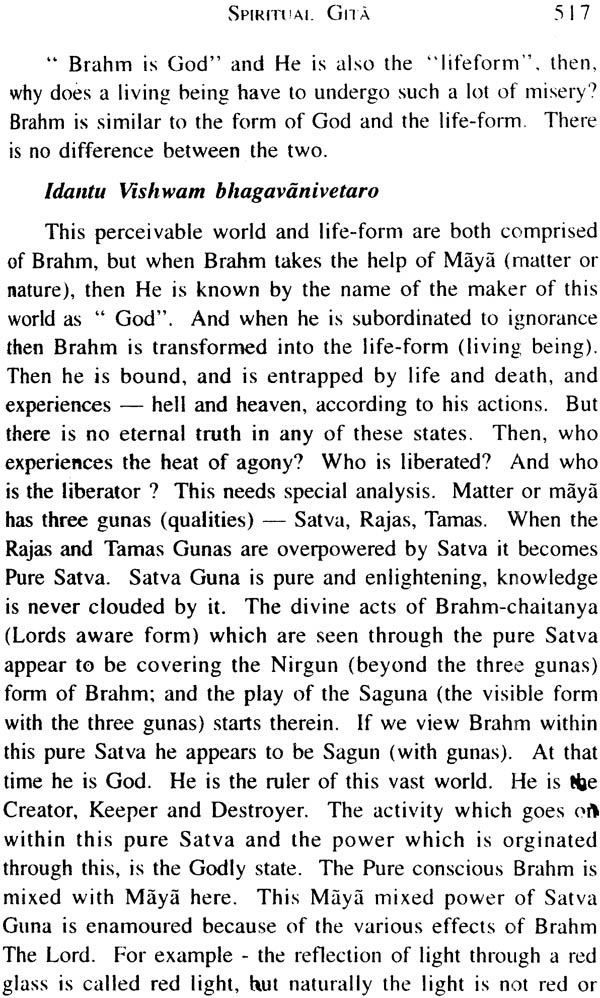
Spiritual Gita (Set of 3 Volumes)
Book Specification
| Item Code: | IDG122 |
| Author: | Shyamacharan Lahiri Bhupendranath Sanyal |
| Publisher: | Sundeep Agarwala |
| Language: | English |
| Pages: | 1423 |
| Cover: | Paperback |
| Other Details | 8.7" X 5.7" |
| Weight | 1.62 kg |
Book Description
A study of the Indian spiritual writings clearly reveals that gradual development began since hoary past.
Innumerable commentaries, translations and interpretations of Srimat Bhagavat Gita have been made in different languages of the world — which originated from the lotus lips of Sri Padmanäva Naräyan. Though it was written in Sanskrit, however, translations in other languages are also found— which are meant for those who do not follow Sanskrit. The different preachers have explained Gitä, maintaining the principal ideas appearing in the Sanskrit texts — but instilling in a subtle manner their own philosophical doctrines. Thus, in some treatises the dominance of Karma (activity) is noticed while in other versions Jnäna (knowledge) or Bhakti (reverence) is found to be the principal idea. Some schools have explained from the angle of Dwaitabad (Dualism) — others from Adwaitabad (Monism) or Dwaita - Adwaitabad.
Every human being has a birth right to try for self-realization or to know the God. As God is infinite so are His worshippers as well. The way to one’s self-realization is akin to one’s own Sanaskar and Adhikär (Competence) which is determined by the spiritual preceptor or Guru. Hence, some people worship the Lord through Karma and others through Bhakti or Jnäna depending on their proclivity or bent of mind.
There cannot be slightest doubt that a seeker must touch the lotus feet of Sri Han, regardless of his cult.
Like the various means to reach the Supreme Power, the system of Yoga is also one of the most potential because the Yoga Marg compliments and expedites one’s striving for God, no matter, which system one follows. In Srimat Bhàgavat Gita, in all the eighteen chapters from Vishad Yoga to Moksha Yoga — the word Yoga is present always. In the Bhisma Parba of the Mahabharata, Lord Sri Krishna advised Arjun to be a Yogi in the midst of Kurukshetra battle field. The Lord emphasized that a Yogi was superior to a Tapaswi, Karmi or Jnani because a Yogi alone could identify himself with the God. A State of constant union with the cosmic spirit can be achieved only through Yoga Samadhi. Whether it is Bhakti, Jnani or Be-Jnäna, the Yoga system represents a unique synthesis of all the doctrines.
The cosmic power indicated the path of emancipation of the self from the bondage of Myl manifesting itself as l3rahma and revealing in the process Vedas to the mankind. As Lord Vishnu He is preserving the creation and as Lord Shiva He is preaching the Yoga system. The universal teacher in Shiva is teaching the seeker the various systems by which a man can unite himself with the Cosmic Spirit or Parä Brahma. Mantra Yoga, Kriyä Yoga, Laya Yoga, Jnana Yoga, Pars Yoga, Shabhabi and Anianaska Yoga — all these systems of Yoga are being taught by the Supreme Guru Shiva to the seekers according to their ability and capacities. Alt these Yogas have been depicted throughtout eithteen chapters of Srimat Bhagavat Gita and for this reason every chapter ends with the remark “Brahma Vidya Yoga Shastrey etc.
Regardless of the system one follows to achieve the Paramitya Tatva (knowledge of the Supreme Being) — one has to reach the Parbastha of Kriya by practicing only Kriya Yoga. There are no two opinion that one has to read Gita regularly, but the vast spiritual mystery that is embedded within it, must be known, failing which one cannot come out of the whirlpool of birth and death. The intrinsic truth of Srimat Bhagavat Gita is revealed to them who practice Kriya Yoga under the able guidance of a Sad- Guru. To the persons who have not been initiated in the Yoga system, it is practically impossible to have realization of the hidden implications of the Shästras.
Back, in the year 1828 Yogiraj Shri Shyama Charan Lahiri was born in Krishnanagar, Bengal. He started living at Varänasi since his boyhood. It was Sri Sri Lahiri Mahasai, who for the (list time wrote and popularized the spiritual commentaries on Gitä. The aphorisms of revered Lahiri Mahasai on Gitä were very rational, irrefutable and were replete with sublime spiritual thoughts. He himself practiced and followed the path enumerated by Lord Krishna in Gita and established beyond doubt that a family man can also remain in communion with the Supreme Being, while performing all mundane duties of the family. Being an ordinary family man he used to remain always in the state of Parabastha by practicing Kriya Yoga. He was the living epitome of Srimat Bhagavat Gitä and compassionately guided his disciples to the path of “Sayujya Mukti”. This great seer, who perceived the ‘Truth’ himself, prepared the spiritual commentaries on Gita in a very concise soon and is intelligible to them only, who have made some progress in the Kriya Yoga sadhan.
Sri Bhupendra Nath Sanyal Mahasai had written a lucid and exhaustive narration of Lahiri Baba’s cryptic version, which can he understood even by the common folks besides the Kriyaban Sadhakas. Sri l3hupendra Nath Sanyal Mähasai was initiated in Kriyã Yoga from the Yogiraj in his boyhood and ascended the highest peak of Yogic realization during his life time. He was an erudite scholar in the Bengali and Sanskrit literature and had the honor of writing many a valuable book in Bengali language. Hence, it is quite natural that such a noble work could he achieved only by him.
Yogiraj Shri Shri Shyama Charan Lahiri Mahâsai in 1868 at Ranikhet in Himachal Pradesh froth Babaji Maharaj to teach this Gita-based Kriya Yoga of common men.
Many years ago, Yogiraj used to print and distribute to his kriyaban disciples the mysterious and spiritual connotations of Srimat Bhagavat Gita Those editions are practically out of print and rare today. Some of his advanced disciples used to print such books subsequently to distribute amongst the Kriyäbans.
Shri Panchanan Bhattacharya was a leading disciple of Yogiraj and he got many religious books of Lahiri Mahasai printed during his time. Following the same tradition, many more advanced disciples like Swami Keshabnanda, Yukteswar Giriji Maharaj, Harinäräyan Palodhy, Sri Ramdayal Majumdar, Swami Pranabananda also explained Srimat Bhagavat Gita from the Kriya Yoga angle.
There is no doubt that all ever the world more and more people are being keenly interested in realizing hidden truth in Srimat Bhägavat Gita Slid Slid Lãhiri Mahasai once remarked that hundred years after his demise, Kriya Yoga would be popular worldwide. Our present time which marks a conjunction of Satya Yuga and Kali Yuga is the scheduled time as per the statement of Slid Slid Lattiri Mahasai.
As we Indians are eager to quench our thirst for spiritualism through the Gita, in a similar way millions of people outside our country are feeling the same urge as ourselves. The Western countries have been endeavoring since long to unfold the mystery of Indian Yoga system but it will be successful only when the right time will appear. Notwithstanding, there have been many translations of Srimat Bhagavat Gita in different languages since long, it however, appears that the translations of the versions of Shri Shri Lahiri Mahäsai and that of Shri Sanyal Mahasai containing, inter-alia, ‘Adhyatmik Dipikã’ was not attempted before by anyone. Maybe the divine wishes of the great Guru Raj Rajeswar has prompted Srimati Chandra Sänt Agärwala to transcribe the same in English. Srimati Chandrakanta was a direct disciple of Sri Sri Bhupendra Nãth Sanyal and is an old Kriy Yogi. I have definite information that she is practicing Kriyi with sincerity from her early teens. I have heard many a time from my revered Gurudev Sri Sri Jawala Prasad Tiwri about her regularity, punctuality and controlled life.
Sri Sri Tiwäri Mahasai was one of the most advanced disciples of Sri Sänyal Mahäsai and both Chandrakanta Devi and her mother Late Triveni Bai were Guru sisters of Sri Tiwari Bait Her husband, Shri chandra Kumar Agarwala, who is not alive today was also a staunch devotee of Sri Sanyäl Baba.
That Srimati Chandrakanta Devi is the most competent person for this noble and difficult mission leaves no scope of doubt to me. Discharging her total responsibilities towards her children and accomplishing all domestic duties perfectly she is engaged in Sadhan Bhajan a similar example in this Kaly yug is not easy to identify. She is well educated Sadhika and Bhakt and it seems to me that her Gurudev has bestowed the responsibility to the fittest candidate. I am sure that the readers in the western countries will be immensely benefited by her translation work.
I am an humble person having no trace of Bhakti Jnana nor any education. The reason why Chandrakanta has chosen me for writing the introduction is not clear to me. I do not consider myself competent to write the introduction but by the grace of Sri guru Madhab even a lame man can cross the mountain.
Before I conclude I pray to my Gurudeva Param Guru Parapr Guru, Guru Mata and Lord Sri Krishna that the transcription of Sri Lahiri Mahasai and Sri Sri Sanyal Mahasai’s commentary on Srimat Bhagavat Gita be cordially Maharaj for Srimati Chandrakanta’s.
Gita has been told and explained many a times by great scholars but the deep yogic spiritual light by Shree Shyamacharan Lahiri and its analysis as given herein elaborately and in steps by Shree Bhupendra Nath Sanyal is seldom seen.
Every chapter of Gita deals with yoga starting from the fist chapter visad yoga to the last one which is moksha sanyas yoga we can say it starts from the crying or birth of mankind to the liberation or moksha which can also be called death.
I have tried to keep the subject matter quite like the original script so that the grasping of it may be as easy as possible but of course it is an uncommon very deep spiritual aspect of yoga which at places may be a little difficult to understand. Yet if it arouses interest in knowing and understanding or better still in practicing the art or Sadhna of yoga the ultimate aim of which is to unite the living being with the supreme I would be gratified.
Any effort made here is by the lord for the lord and to the lord.
Yet I must not forget to thank Mrs. Lakshmi Chamaria who initiated me into the act of this translation then Dr. Indranath Chakraborty who encouraged my be approving the work and Mrs. Rashmi Khaitan who did the reading before the final proof and last but not the least all those who are happy about it and kept boosting up my spirit.
Bhagavad-Gita is a rosary (garland) of ‘Mantras’—Mantras are a kind of language or speech, but like other words they do not tie us to this world; most of us are in bondage of worldly matters because of spoken words only, like the sweet baby words to the loving dialect of our dear ones. Even enmity is caused by words. The power of words can create endless waves of love and hatred in our mind & heart. The sound of music, a speech or even a book all based on sound and word effect our lives the utmost.
Life giving ‘Breath’ is the base of words without which we are lifeless and unable to speak or so to say do any thing at all. Our Life is in bondage by words but this is words’ external power—it also has an internal power. Those internal power words are known as ‘Mantras’ and mantras have the strength to free us of bondage.
The Gità is filled with such mantras so it can be called a ‘Mantramala or garland of Mantras, These mantras have to be meditated upon under the guidance of a proper ‘Guru’ to free one’s self. The secret of mantras is less known in countries other than India, thus this country is most developed in spiritual knowledge. By the influence of other cultures we have learnt to disregard this valuable asset of ours. If only we all become aware of our internal properties we shall realize that we are the children of almighty God where there is no Death or Birth, we shall be one with him and be able to enter our own, very own home forever.
As our experienced Saint ‘Gurus’ say—our understanding of the Body & Soul as one, is the foremost reason of our Bondage to this world. Our sky of knowledge is covered by so many dark clouds of worldly colors that we do not even become aware of our true self. If by God’s ‘Grace one does become aware, there are so many hurdles, the knots of love and hatred, of wealth and wisdom, of sickness and health, of beauty and ugliness, of wants and wishes to which there is no end. Wise wish to become wiser, wealthy wealthier and so on—the knots get stronger with our worldly actions. If we want to free ourselves we must learn from an experienced teacher. The path to freedom from worldly bondage is so narrow that in the words of ‘Kabir’ — “two will not be able to stand side by side, if the Lord is there you will be missing or if you are there He will be missing” In other words you will have to become one with the almighty’.
The path is so slippery and difficult, you have to be very cautious, so that you do not fall. It is very high so you will have to climb with patience and in a way that you do not get over tired and give up mid-way.
These are few reasons, why the travelers of this toad are so few; but once we understand that we are no other than the Lord Himself—”Soham”, just like electricity goes from one power House to so many places; we shall be able to enlighten ourselves with the light of the endless light —.— the ‘Brahma’ or the Lord.
Thus, to make this path easier, it is advised to be in good company, that which will encourage you to become a steadfast traveler, to make way for the values of life, like learning to give, and help others in need, going to places of pilgrimages where you see people facing hurdles just to get a glimpse of their favorite idols and hearing hymns and glories sung to the Lord. These will help to turn your inner-self towards the wanted goal.
As all this enlightens the flame or torch of this path it will also burn your worldly wants slowly but surely. Since no grass grows on a burnt piece of land, no worldly wishes will grow in your heart where it has been scorched with the (warmth) heat of God’s loving flame. As this flame rises and starts to burn you, the Lord, merciful as He is, will not be able to he just a spectator, but will shower his blissful cool waters and make you one with Himself—that is ‘Soham’.
Devotion to the Lord makes discomfort in ‘Sadhna’ or worship lost. Meditation—in a natural way calms and purifies the inner- self or ‘chit’.
The aim of all religions is to gain liberation from the worldly sorrows. No matter what we do, the cycle of nature keeps rotating and we have to bear both pain and happiness. Thus, if we can decide as to what is our life’s aim, then we are able to put forth our energy to achieve it. Aiming for this ultimate achievement and trying to succeed in it, is the essence of humanity. In the Gita, this subject is told repeatedly in different aspects and aspirations. By God’s grace, ii we can attach ourselves with the Lord by ‘Yoga’ — we shall be able to rise and get nearer to Him day by day.
True sentiments can only produce true form of poetry—such is the Gitä, written in verses that can create a tempo which can change our underlying seeds into seedlings according to our mental conditions and then only, can we feel it grow.
If you sing the Gitä with love and devotion, the vibration of the Gita ‘Mantras have the capacity to make you spell-bound and due to your ‘sadhna’ your energy force will become introvert instead of being just lost in the outside world. This is the greatness of the Gitä mantras and thus we can call it the essence of all religious texts, one which can make you obtain ‘Moksha’ or liberation from birth and death.
Lord Krishna is the giver of Gitä Mantramala (rosary of Mantras). Unless we understand the Lord, it will not be possible to gain full benefit from the Mantras. Krishna is the supreme God, but is not commonly understood by people, as he himself told Arjun (his devotee and friend) that ‘you see me not, rather you do not have that sight by which you can see me’. Thus we have to depend on Him to give us that sight—that heavenly sight—after getting such a Divya Drishti (sight) we shall understand that one Lord is present in all beings seated deeply and minutely.
Hurdles have to be faced before accomplishing anything worthwhile specially if it is a serious nature and more so if it is spiritual matter. Anyway be they grace of almighty it seems that the stepping stones tot his volume II have been crossed.
By the grace of God Swami Shantananda Giri of Yogoda Satsanga society has written the introduction for which I am very much grateful to him.
Being under the similar banner of Lahiri Mahasaya I am taking the liberty of publishing the encouraging and blissful letter form Yogacarya Ashoke Kumar Chatterjee who represented India at the congress on world Religions held at France in 1997.
By his grace only Jagat Guru Shankaracharya Swami Sarupananda Saraswatiji Maharaj has been kind enough to send a letter of approval for the effort made. A copy of the letter has been given herein as it is.
Devoted efforts take out the fatigue from the work and give a bliss of happiness.
‘My Guru and Paramagurus —- Swami Sri Yukteswar, Lahin Mahasaya, and Mahavatara Babaji are rishis of this present age, masters who themselves are God-realized living scriptures. They have bequeathed to the world along with the long-lost scientific technique of Kriya Yoga a new revelation of the holy Bhagavad Gita, relevant primarily to the science of yoga and to Kriya Yoga in particular.”
“Mahavatara Babaji, at one with Krishna in Spirit, through his grace intuitively transferred the true knowledge of the Bhagavad Gita to his disciple Lahiri Mahasaya a Yogavatara, ‘Incarnation of Yoga’ —— through whom he revived for mankind the Kriya Yoga science as the technique of salvation for this age. Lahiri Mahasaya himself never wrote any books, but his divine expositions of the scriptures were expressed through the writings of various of his advanced disciples. Among his greatest disciples, Swami Sri Yukteswar, Swami Pranabananda, and Panchanon Bhattacharya recorded his Gita explanations. The earliest small edition of the Bhagavad Gita with Lahiri Mahasaya’s interpretations was brought out by Panchanon Bhattacharya, founder of the Arya Mission Institution, Calcutta. Later, my gum Sri Yukteswari Jnanavatara, ‘incarnation Wisdom’ - - elaborate unrivaled way, explained the most significant first nine chapters of the Gita according to Lahiri Mahasaya’s interpretation.”
After that, the great Swami Pranabananda, the saint with two bodies’ (about whom I wrote in my Autobiography of a Yogi), brought forth an amazing interpretation of Lahiri Mahasaya’s entire Gita. The eminent yogi, Bhupendra Nath Sanyal, whom I personally highly regard, also brought out a remarkable edition of Lahiri Mahasaya’s interpretation of the Gita. I have had the blessing to be inspired in the greatest way about Lahiri Mahasaya’s divine insight and perceptive method of explaining the Gita, which I learned first from my Master’
The present volumes of Spiritual Gita are the ‘remarkable edition of Lahiri Mahasayas interpretation of the Gita’’ by Sri Bhupendra Nath Sanyal referred to by Sri Sri Pararnahansa Yogananda in his Introduction to God Talks with Auna, Yoganandaji’s translation and commentary on the Bhagavad Gita. The original Bengali of Sri Sanyal is now rendered into English in a very lucid way by Smt. Chandrakanta Agarwal.
In Volume I of the Spiritual Gita, Lord Krishna introduces the sadhak to the spiritual and materialistic battlefield of his consciousness in the physical and mental body. One is made to understand and recognize the psychological, or thought, forces at play in his bodily and mental kingdoms. Then Lord Krishna elucidates the internal and transcendent nature of the Atman and how through the yoga of right action, the sadhak gains the infinite wisdom of Spirit. The Lord explains the nature of night action and right attitude and how they conquer the two-sided passion of desire and anger. He further explains the esoteric essence of yoga, His way of acting in creation, and the practice of yQg4, the spiritual ‘fire” rite that consumes all karma. Freedom through inner renunciation of the objects of the senses by perseverance in yoga. meditation on God and desire less activity are the ways to attain the supreme bliss of God.
Nevethless I would like to mention the name of dear Krishna who made me aware of what I was aiming at. In the beginning only he said it’s a Herculean task and although he did not question my capabilities still his face was a question mark. By the grace of Guru I did not get discouraged and of course it was not meant to do so either rather it became sort of a challenge but I depended totally on the lord. The task was commenced by his order and is (for now) completed by his blessings. This I am saying not due to humbleness alone but by me experiences off and on during the span of nearly two and a half years that have been the most dedicated devoted and blessed part of my life that was used in the service of the Lord. For it I can only say in the words of Meera Karai Karavai Aap hi nam na Pano leyai.
Although he does everything yet he does not say so.
The reader of this book is sure to get irritated by repetition of some words like Kriya Pranyam, pran, Paravastha etc. yet it should not be taken as a flaw of language but a necessity for drilling in our minds the most confidential spiritual knowledge which is given to us by the Yogesvar Lord Krishan and explained for our benefit by the great spiritual gurus yogiraj Lahiri Mahasaya and Yogi Guru Sanyal Mahasaya.
Any translation cannot compete with the original due to disparity of language thought sentiment and tradition etc. yet other shortcomings herein can be attributed to my little knowledge and yet others may be due to mistakes in printing etc. the patrons of Gita will kindly excuse these drawbacks.
Still it is well said that the proof of the pudding is in the eating. This pudding anyway will have to be cooked by the self for the actual experience of it. The recipie has been explained herein as far as possible in writing but the practical part has to be known from the spiritual master or the guru and practiced by the self. The smell and taste of this pudding will enchant the mind please the sight and satisfy the self totally and eternally.
May the Lord bless encourage and help us to nurture the tree of spirituality which will give us the divine fruit of our nutritive acts.
| given in italics after the translation of each text and before the elaborate explanation of Yogiguru Shree Bhupendranath Sanyal Mahasaya. | ||
| INTRODUCTION | 1 | |
| PREFACE | 9 | |
| FOREWORD | 11 | |
| CHAPTER I Vishad-Yoga or Depression of Spirits | 34 | |
| CHAPTER II Sankhya-Yoga or Reasoning of Spirits | 80 | |
| CHAPTER III Karma-Yoga or Action | 159 | |
| CHAPTER IV Gyan-Yoga or Knowledge | 221 | |
| CHAPTER V Karma-Sanyas Yoga or Action and Renunciation | 304 | |
| CHAPTER VI Dhyan or Abhyas Yogar or Meditation or Practice of Yoga | 345 | |
| Index | 424 | |
Title: Spiritual Gita (VOLUME II)
| given in italics after the translation of each text and before the elaborate explanation of Yogiguru Shree Bhupendranath Sanyal Mahasaya. | ||
| Chapter VII KNOWLEDGE OF SPIRITUAL SCIENCE | 1 | |
| Chapter VIII UNITY OR YOGA WITH THE SPIRITUAL SOUND (BRAHM) | 48 | |
| Chapter IX THE MAJESTIC CONFIDENTIAL KNOWLEDGE | 106 | |
| Chapter X THE YOGA OF MAGNIFICENCE | 174 | |
| Chapter XI THE UNIVERSAL FORM | 240 | |
| Chapter XII DEVOTIONAL YOGA | 320 | |
| INDEX | 387 | |
Title: Spiritual Gita (VOLUME III)
| given in italics after the translation of each text and before the elaborate explanation of Yogiguru Shree Bhupendranath Sanyal Mahasaya. | ||
| A PRAYER | 1 | |
| Chapter XIII CONSCIOUS DISTINCTION BETWEEN NATURE AND MAN (SUPREME) | 2 | |
| Chapter XIV THE 3 MODES OF MATERIAL NATURE | 103 | |
| Chapter XV YOGA OF THE SUPREME MAN | 169 | |
| Chapter XVI THE DIVINE AND DEMONIAC NATURES | 226 | |
| Chapter XVII | 268 | |
| Chapter XVIII THE YOGA OF LIBERATION THROUGH RENUNCIATION | 315 | |
| Summary of the Whole Gita | 503 | |
| Appendix | 560 | |
| A Few Words | 565 | |
| A short life sketch of Shree Lahiri Mahasaya | 571 | |
| Word Index (Volume III) | 591 | |
| Subject Index of the 3 volumes | 593 | |
